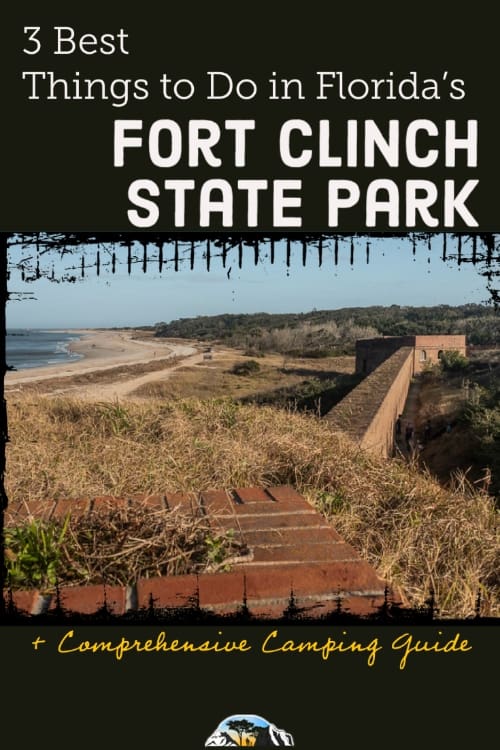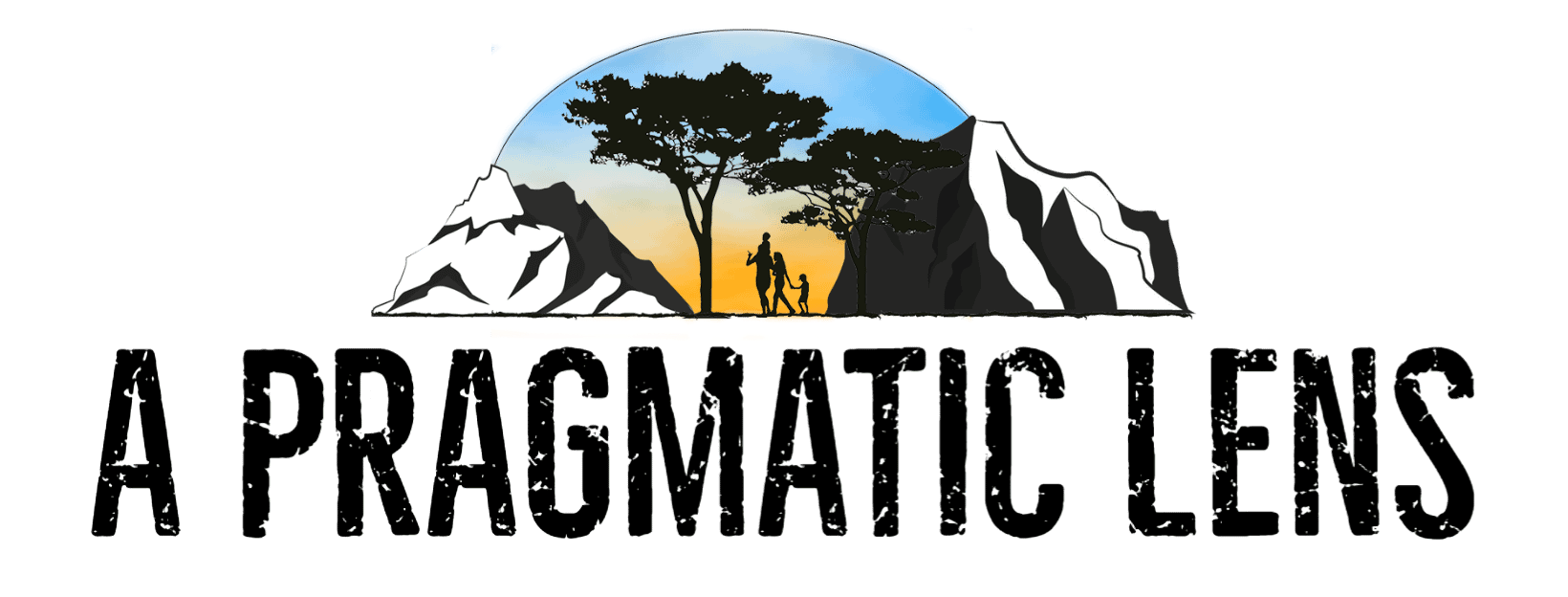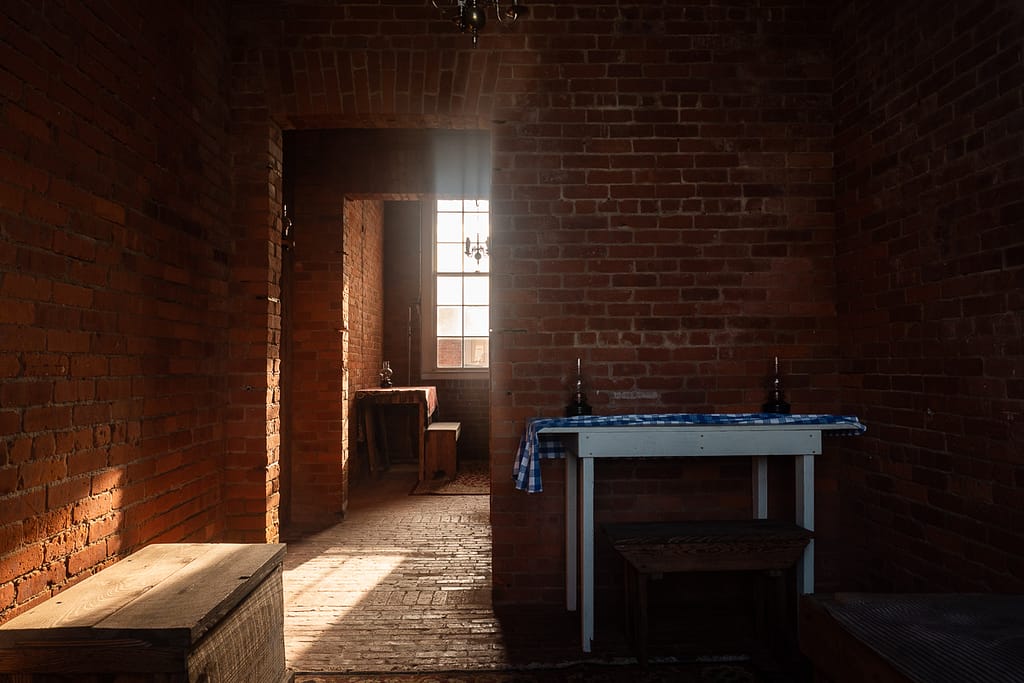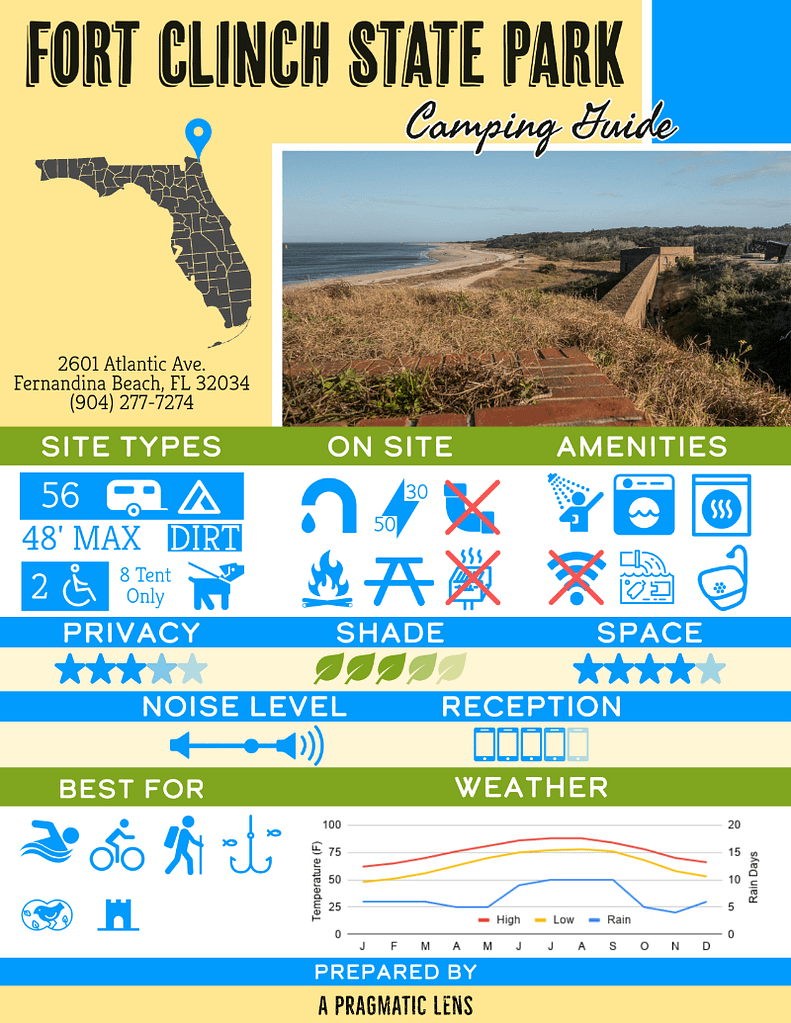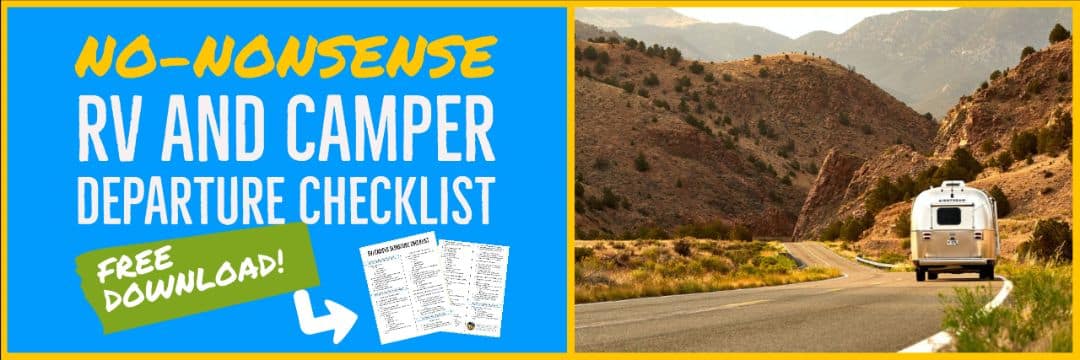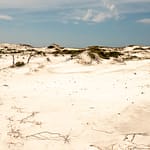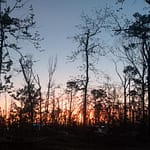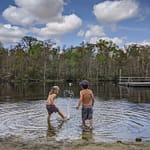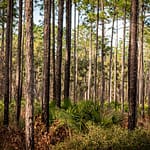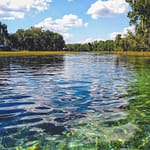Camping at Fort Clinch State Park was a fun experience for the whole family, as it offers all sorts of different adventures! In this article, I highlight the three best things to do in this coastal state park. I also provide a detailed campground review to help you plan your next adventure.
Let’s dig in!
This post may contain affiliate links. Visit the Disclaimer page for more information.
3 Best Things to Do at Fort Clinch State Park
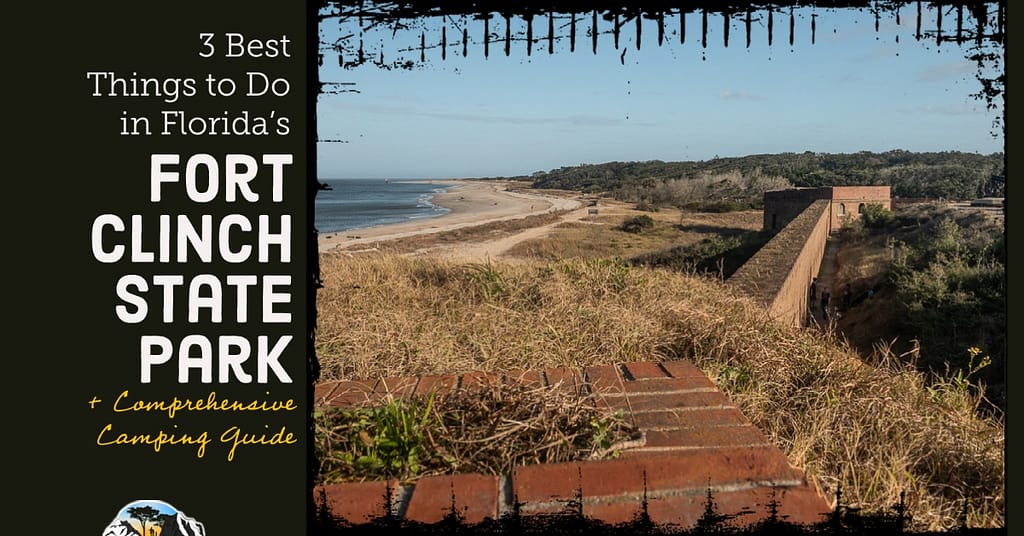
Walking on the Beach
It may seem like a no-brainer, but I usually find walking on the beach rather underwhelming.
That was not the case in Fort Clinch, as the vast sandy landscape is certainly a sight to behold!
There are a few beach areas to explore, and they are not exactly close to each other.
Amelia River
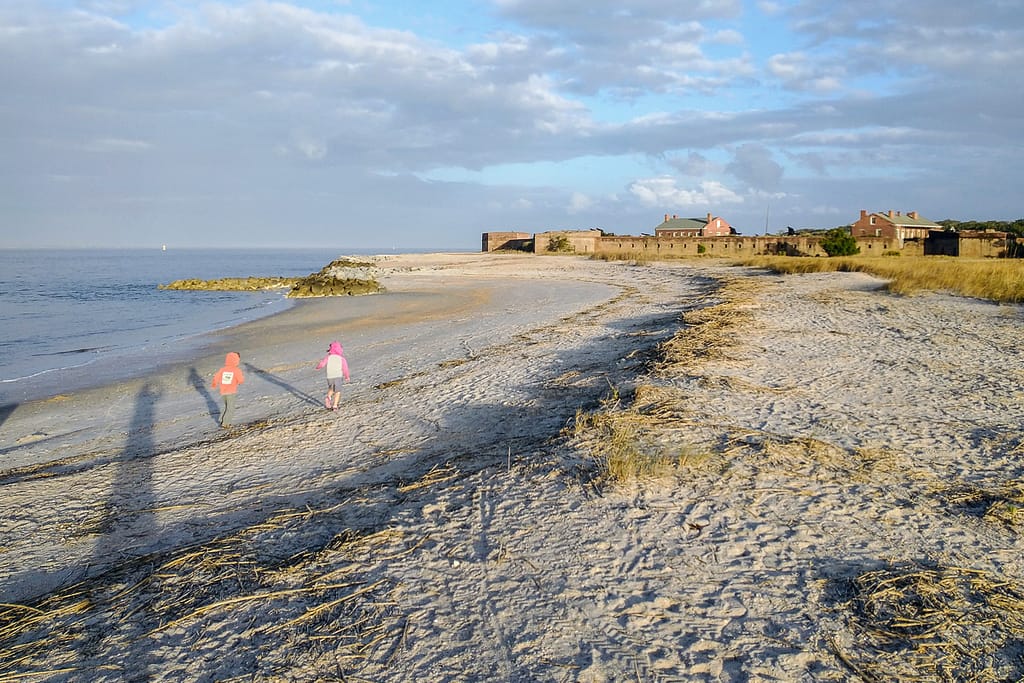
One of the areas is by the Amelia River, which is quite easy to access if you are camping in the Amelia River campground. From here you can walk along the beach all the way to the fort. To return, you can either walk back on the beach or pick up a nature trail that will bring you right back to the Amelia River Campground.
Even if you do not feel like walking, the sunsets here are breathtaking! And another really cool feature is that you can see Cumberland Island, GA from here.

If you are not camping in the Amelia River Campground, you can still drive over to this area to explore this side of the river. However, keep in mind that there are only a handful of parking lots, so you may want to make sure it is not busy. The other option is to bike over, although this park is large! Be prepared for fairly long bike rides if that is your choice.
Related: Little Talbot Island State Park Campground Review
Atlantic Beach
There are two main points of entry to get to the Atlantic Beach in Fort Clinch State Park. One of those areas if from the Atlantic Beach campground itself, as there is a short boardwalk that connects the campsites directly to the beach!
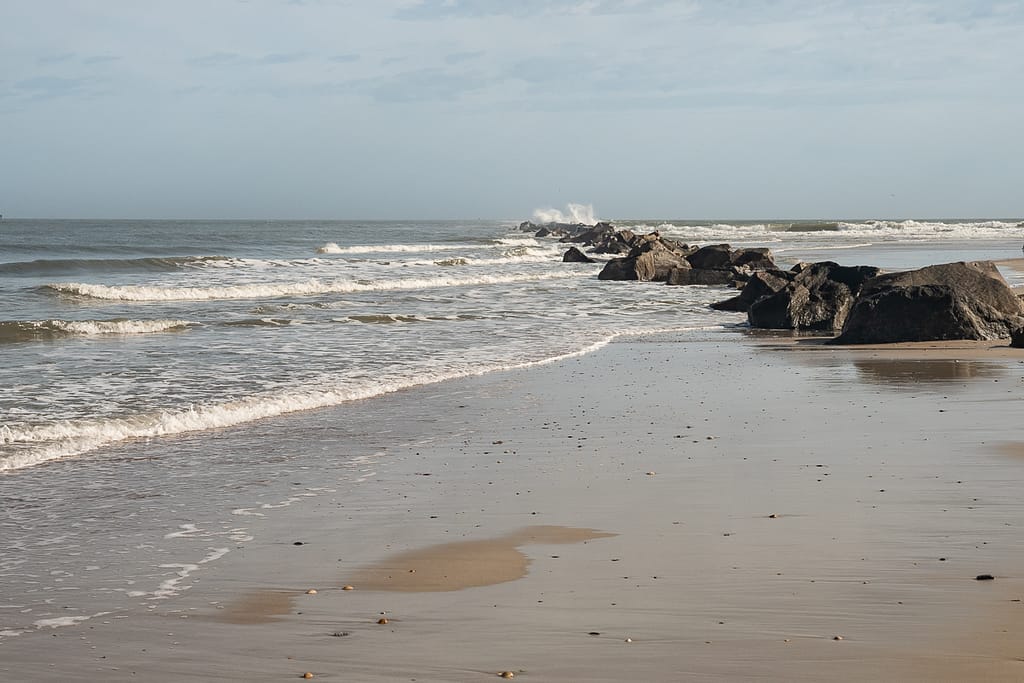
This side of the Atlantic beach is somewhat sheltered by what is left of the Pier, providing calmer waters that are probably more ideal for swimming or wading. This is especially important if you have little kids!
The other area is the East Beach access. This is more of a day-use area, and it offers a large parking lot with plenty of spaces, as well as a nice bike rack, that connects to the beach through a long boardwalk. There are well-maintained restroom facilities in the boardwalk, as well as outdoor showers to rinse off the sand.
In the campground map the fishing pier is still marked. However, the pier is non-existent! As it turns out, the pier sustained irreparable damage during Hurricane Matthew, which pounded the coast in 2016. What is left is the supporting structure that once held it in place.
While I saw people braving the narrow structure to fish on the far end of the pier, I suggest you avoid it. Particularly during high tide or high winds, the waves can get quite relentless and dangerous!
While the fishing pier is no longer good for fishing, it is still a beautiful structure that shorebirds use as a refuge and a place for them to get a quick snack.
Walking around the Atlantic shore on low tide, looking for shells and simply enjoying the breeze is quite an enjoyable activity. You will also get to see beautiful shorebirds, include royal terns and sanderlings.
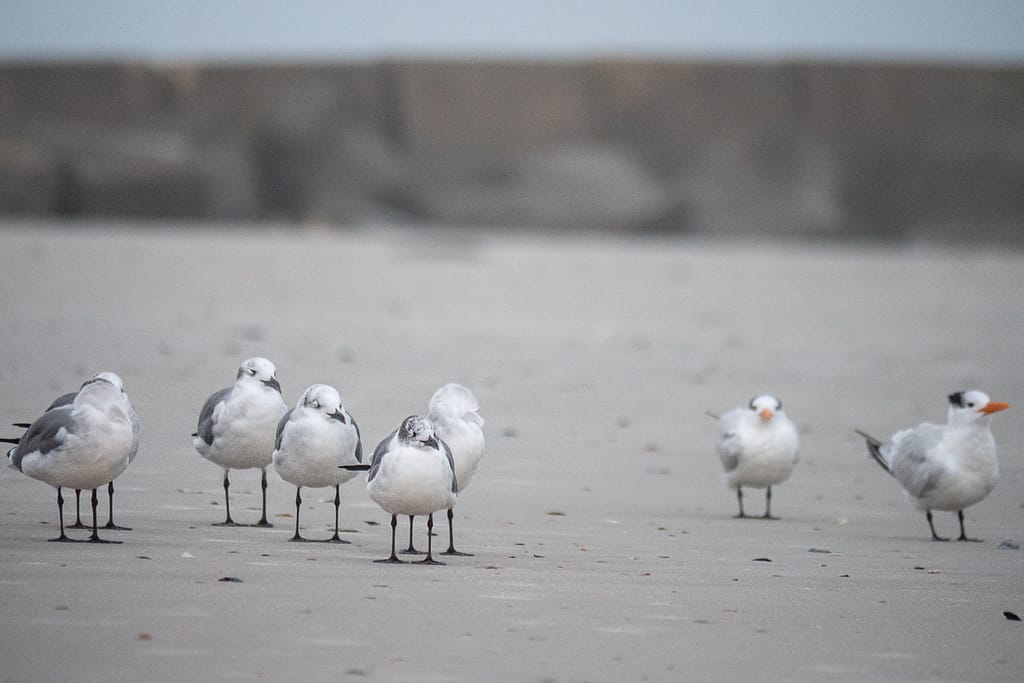
As the biologist and nature-lover that I am, I will take this opportunity to make a PSA. If you have little kids, I would implore you to teach your children to respect these birds. This is their home and their place of rest. Chasing after the birds may seem like a fun and harmless activity, but the reality is that you are disturbing them!
Related: 5 reasons to Visit Anastasia State Park
Biking
Biking in Fort Clinch State Park is a rather major activity. One reason is that this park is large, and the other is that the trails are shared.
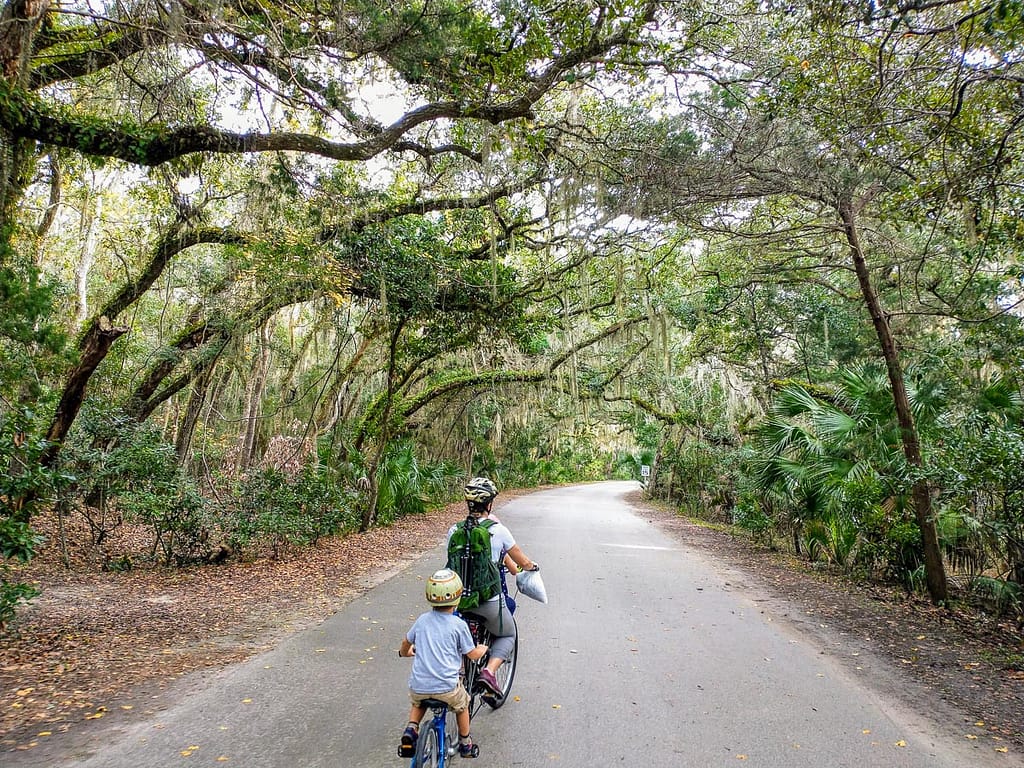
The park is large, so you will need to consider having a way to get around. One option would be a vehicle, which is simple enough if you are already towing a travel trailer or car camping. You could also bring a golf cart, just make sure you choose a site large enough to accommodate it. Lastly, there is always biking!
Biking on the campground and park roads is a pleasant experience. The roads are paved and for the most part shady, with several beautiful “tunnels” created by the rich tree canopy. The only exception to this is getting to the Atlantic side, where the canopy opens up and you will be biking in the sun.
All in all, the campground and park roads will give you around 6-7miles of biking, depending on where you start from and any “detours” you may take to explore the rest of the park.The only disadvantage is that there is no designated bike. While there are several signs on the road for cars to be careful with bikers, do keep in mind that traffic can still be a bit heavy.
But what if you prefer the more adrenaline-filled mountain biking? Well, while there are not mountains, the trails in Fort Clinch State Park are designated “shared-use”, meaning you can also bike on them!
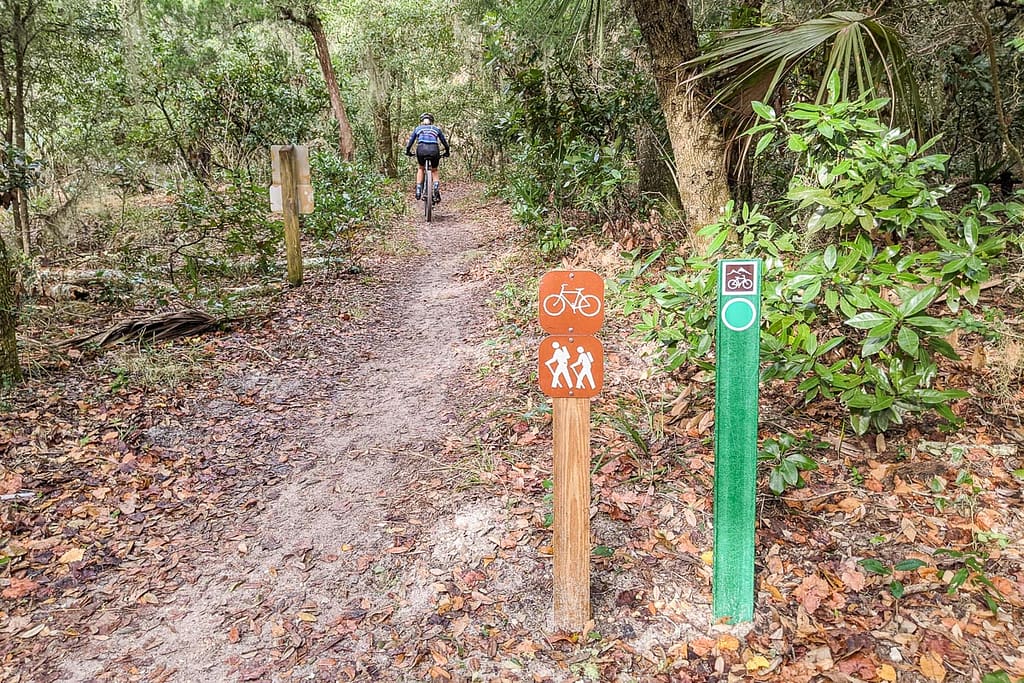
The mountain bike paths are one-way and parallel the main road to the most park, looping around and crossing the roads at different intersections. While there are signs on the road notifying motorists of these crossings, you should still be careful as you approach these.
As the trail goes through steep sand dunes and narrow passages, it is considered an intermediate level biking trail and it is important that you are familiar with mountain biking before you get started. And, due to the risky nature of the activity, helmets are required. Lastly, be mindful of hikers as they are also allowed to use the trails and can walk it in any direction.
Related: Payne’s Prairie Preserve State Park Campground Review
Visiting the Fort
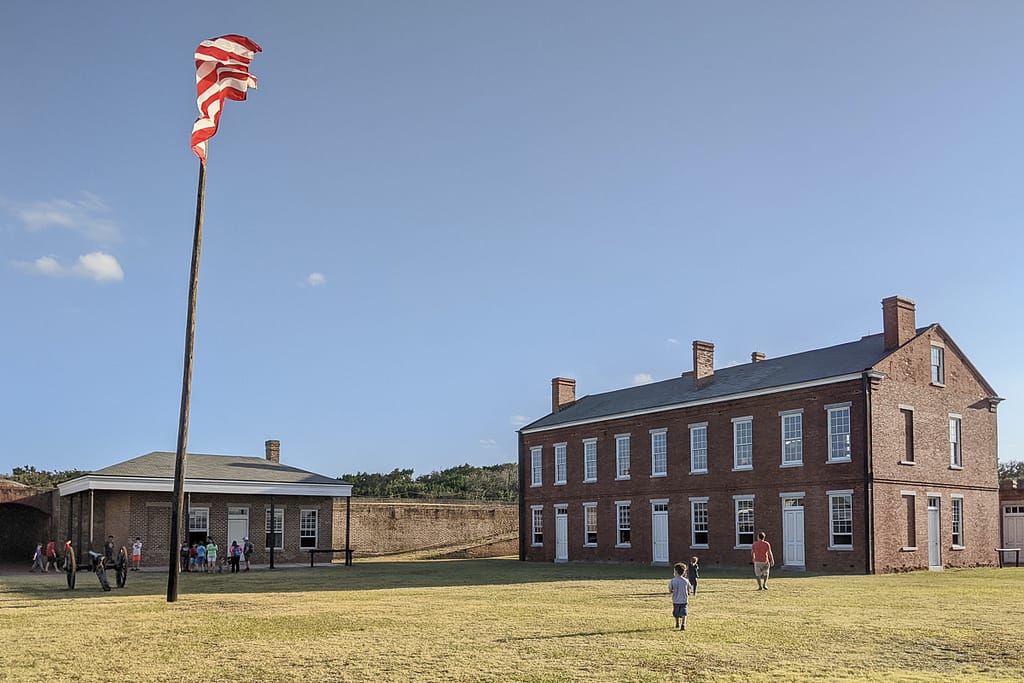
While technically you can walk to the outside of the Fort from the Amelia River campground, in order to go in you will need to bike or drive to the visitors center. At the time of our visit, masks were required to enter the visitor center, and Fort passes cost $2.50 per person.
A bit of history, construction of the Fort began in 1847, after the War of 1812 inspired a desire to protect the United States’ coastlines against other nations. After going through periods of abandonment and switching hands for a number of years, the historical significance of this Fort resulted in Fort Clinch becoming one of the first State Parks in Florida in 1935. You can learn more about the history of Fort Clinch here.
I have seen several forts in my life, and many tend to be a bit underwhelming because usually several areas are closed and leave little to see and explore. That was not the case here at Fort Clinch. There are many corners to explore and windows to peek through to get a glimpse of like at the fort!
I was surprised to see that my children greatly enjoyed visiting the Fort, but perhaps I should not have been surprised. There is a large grassy space in the middle to run around, several tunnels to explore, long-windy stairs, and of course, cannons!
Related: Collier Seminole State Park Campground Review
Other Activities at Fort Clinch State Park
Hiking
There are a few hiking trails to explore in Fort Clinch State Park. One option is a 6-mile trail that parallels the main road and crosses it at a few points. This is a shared-use trail, meaning that mountain bikers also transit it. This trail goes through densely forested areas and sand dunes, offering a fun challenge for hikers.

There is also the Willow Pond hiking trails, which gives you a choice of two loops to explore. As the name implies, the trails wrap around freshwater ponds where you will be walking through paths lined with live oaks and cabbage palms. These trails are shorter and easier than the shared-use trail, with only a couple of areas where you will need to climb over sand dunes.
While not exactly a hiking activity, make sure you stop by Egans Creek Scenic View. It is toward the beginning of the park, and you can drive or bike to it from the camground. You will see gorgeous views of the marshes on Egans Creek, as well as get a glimpse of the Amelia Island Lighthouse.

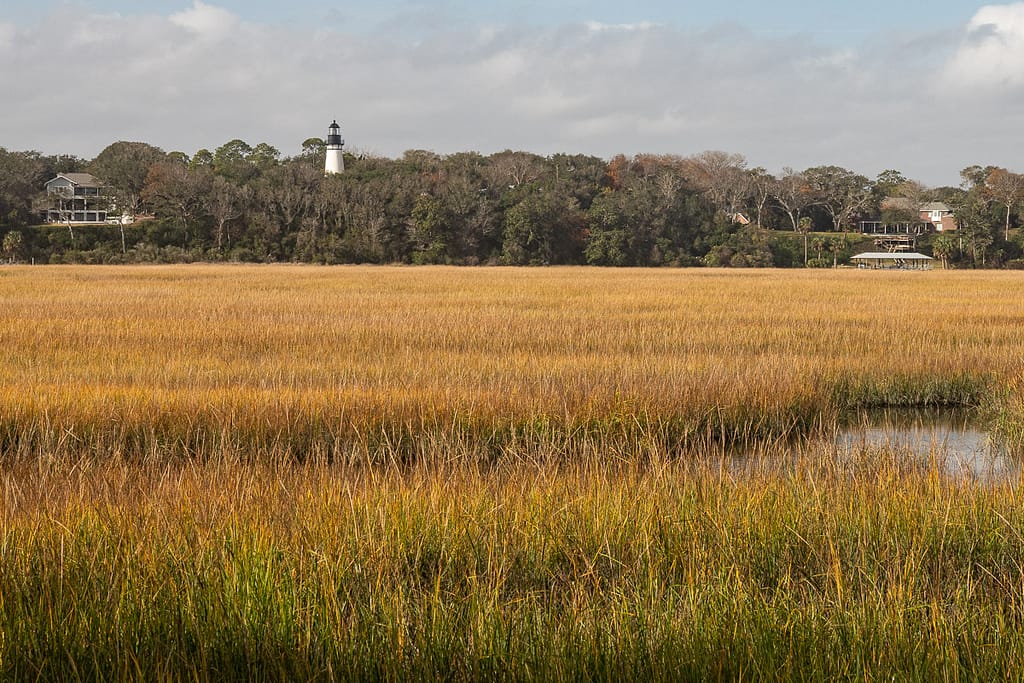
Fishing

While the large pier is no longer in place due to the damaging effects of Hurricane Matthew in 2016, there are still quite a bit of fishing opportunities.
One option is to enjoy a day of cast fishing from the beach. Another popular area is near the jetties on Fort Clinch. Lastly, if you are camping, the Amelia River campground also has a platform to fish.
Kayaking
While there are places to launch kayaks near the campgrounds, or from the parking lots by the visitor center, be mindful that this region is known for strong currents. In addition, the heavy baot traffic makes kayaking in the Amelia River not ideal.
If you still want to go for a paddle, it is better to go to Egans Creek Park just outside of Fort Clinch and launch your kayak into the creek. Egans Creek has less boat traffic and the currents are not as strong. From Egans Creek, you will also get to see Amelia Island Lighthouse.
Fort Clinch State Park Camping Guide
Feel free to use the code below to share this infographic on your website!
<p><strong>Please include attribution to https://apragmaticlens.com with this graphic.</strong><br /><br /><a href='https://apragmaticlens.com/fort-clinch-state-park/'><img src='https://ml0cur3zhy5j.i.optimole.com/w:auto/h:auto/q:mauto/ig:avif/f:best/https://apragmaticlens.com/wp-content/uploads/2021/06/Fort-Clinch-State-Park-Info-2.jpg' alt='Fort Clinch State Park Camping Reference Guide infographic' width='800px' border='0' /></a></p>General Information
Finding the park was straightforward simply following directions using Google Maps. The address is 2601 Atlantic Ave. Fernandina Beach FL 32034. If you need to call ahead, you can reach the ranger’s office at 904-277-7274.
During check in you will receive a handful of maps to get you going, as well as a paper with the directions to your campground. If you have pets, you will also receive a paper tag to affix to your camper window. I am not sure what the purpose of the tag is, but on the back it specifies rules to be aware of.
The Campground Roads
There is a long road before you arrive at the campground loops. The road is in good condition and paved, making it overall a pleasant drive.
Do know that there are a few areas where tall trees lean into the road, so it did make us a bit nervous at a few points where it seemed they would hit the top of our camper! The great thing is that these areas are preceded by a warning sign, and what you will need to do is simply go slow in the middle of the road. We saw plenty of tall fifth wheels and motorhomes in the campgrounds, so it is certainly doable.
After about 2 miles, you will see a sign directing you to the Atlantic Beach loop. You will take right and follow the road until the end. If you are going to the Amelia River campground loop, you will continue for an additional 1 mile. You will see the road splits and there is a gorgeous live oak tree in the middle of it. You will take a left and follow that road until the end.
Amelia River Campground

We are not big into beach camping, so we chose to stay in the Amelia River campground loop instead. This loop is almost completely shaded by a canopy of live oaks and palm trees. There is also a good amount of vegetation between the 43 sites, providing a sense of privacy.
The road within the loop was interesting. It is a one-way road, which is nice. It is paved from the beginning through site 39. After that, and until the road loop ends at around site 53, it is a dirt road.
All the sites are packed dirt, but we did not notice any major issues when it came to leveling campers. As expected, the sites do get a bit muddy during rain. All sites come with a clothes line, a picnic table, and a campfire ring.
Best and Worst Sites
Site 53 SIte 22
We stayed at site 22, which is the right after the dump station. This was one of the last sites available, so we thought it would be terrible. As it turns out, there is enough vegetation that the dump station is not visible from our site. The proximity ended being a convenience, as we were able to easily walk our portable waste tank without much of a hassle!
Our site was also quite private and spacious being at the end of the loop because it was at the end of the loop. As far as I could tell, this is arguably the best site in the Amelia River Campground loop.
In terms of privacy and shade, sites 40, 42, 53 are the runner ups. If you prefer pull-throughs, then your only option is site 63.
As far as sites to be mindful of, or avoid if possible, we have sites 60 and 62. These sites are right in front of the dump station, so not only do you have that as a view, but also camper traffic ready to dump their waste.
Site 36 is interesting because it is right on a road that cuts through the middle of the loop. It would seem like a nice private site, but it is actually not. It is also a bit tight of a space to maneuver and park a camper.
Lastly, I would avoid site 50. It is shallow, with almost no privacy or shade.
Atlantic Campground

The Atlantic Beach campground at Fort Clinch State Park is one of the few I have seen with camping just a short walk from the beach. This campground is located just before the sand dunes, and it is wide open with scattered palm trees. As expected, there is no shade or privacy.
The road is just one short, paved loop with 21 sites around a bathhouse. The sites are hard-packed sand and seemingly level. The sites also come with a campfire ring and picnic table.
There are also six (6) tent sites with parking just off the road, which provide a decent amount of separation between road traffic and your tent.
Best and Worst Sites
Sites 8 and 9 surrounding the walkway to the beach Tent sites
It is difficult to choose in this case, because none of these sites will offer any privacy or shade.
At best, based on the way the sites are angled, sites 6, 7, 19, and 21 will offer a touch more privacy than the rest. If privacy is not a big deal to you but you want views of the dunes, then sites 8-14 will work. Do know that regardless of where your site is, the ocean is not visible from the campground. This is because of the long stretch of dunes in between the campground and the beach.
The sites with the least amount of privacy are sites 8 and 9. These sites flank the boardwalk that takes you to the beach. While it may seem desirable to be close to it, the other sites are not that much farther away. Instead, you will just get a parade of people walking by your site to get to the beach.
The Bathhouses
Atlantic Beach Campground Bathhouse Laundry Area Amelia River Loop Bathhouse
Each campground loop has its own bathhouse, each of which are certainly some of the nicest I have seen in a state park. The buildings are made of brick, adding beauty to the campgrounds are opposed to being clearly a bathhouse facility.
There are washers and dryers in the bathhouses, but keep in mind that they are rather pricey at $2 each. Make sure to bring plenty of change!
Other Considerations
Cell Signal
Within the campgrounds, AT&T and Sprint/T-Mobile have limited reception. I was able to get decent reception with Verizon, which allowed me to work remotely with some limitations. With a booster you may be able to stream video.
Noise Level
This biggest issue with this campground is the noise level. There is a paper mill next to the state park that makes a low roaring noise all day and all night. It is more noticeable in the evening for some reason. It is particularly strong in the Amelia River campground, being slightly less noticeable from the beach campground.
About pets
Dogs are allowed at the campsites, but not on the boardwalks, beaches, or the Fort. Also, there are sandspur in the beach campground, so it is probably best to stay in the river campground if you want your fur babies to tag along for the adventure.
Final Thoughts

We found our stay in Fort Clinch State Park to be quite pleasant. There were many different activities to do, with biking and hiking being fairly big here. The beach is gorgeous, with lots of shore birds to watch and shells to collect.
The Fort itself was quite fun to explore, providing a nice way to spend an hour or two of the day, and learning more about the history of the region.
We love that there is a choice in the campground for those that prefer to stay near the beach, versus those that prefer wooded settings. The biggest issue is the paper mill noise, but it is manageable for a couple of days.
All in all, be sure to add Fort Clinch to your bucket list of Florida Campgrounds. And, as always, let me know if I missed anything by dropping a comment below!
RV and Camping Resources
RV Trip Planning
PIN FOR LATER!
